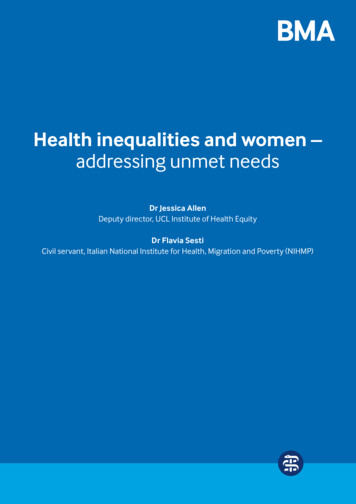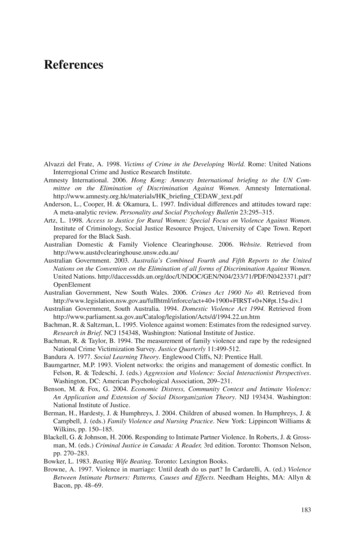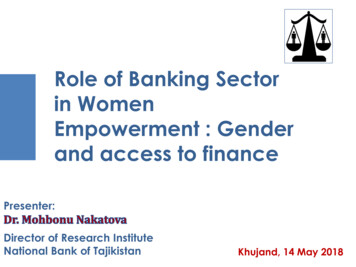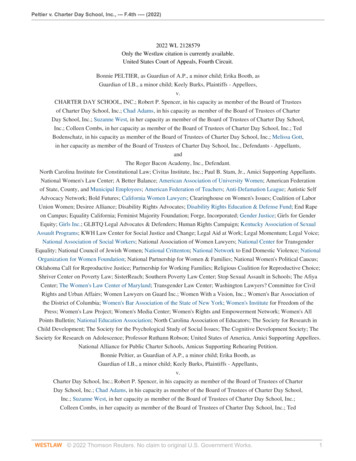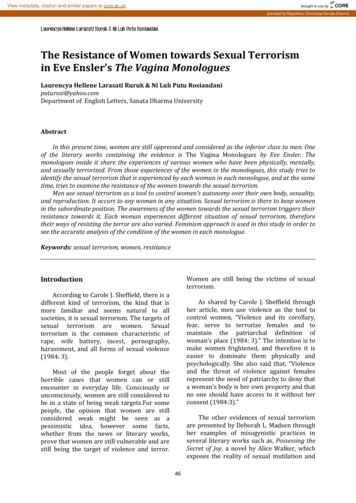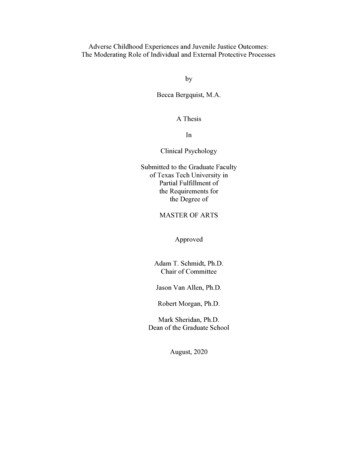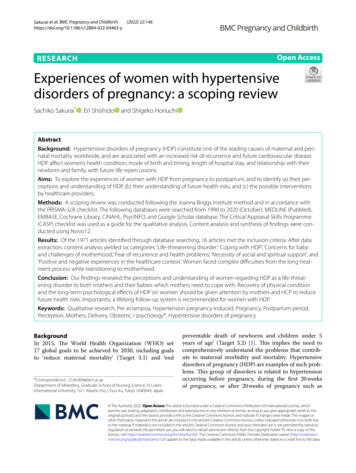
Transcription
(2022) 22:146Sakurai et al. BMC Pregnancy and -yOpen AccessRESEARCHExperiences of women with hypertensivedisorders of pregnancy: a scoping reviewSachiko Sakurai* , Eri Shishidoand Shigeko HoriuchiAbstractBackground: Hypertensive disorders of pregnancy (HDP) constitute one of the leading causes of maternal and perinatal mortality worldwide, and are associated with an increased risk of recurrence and future cardiovascular disease.HDP affect women’s health condition, mode of birth and timing, length of hospital stay, and relationship with theirnewborn and family, with future life repercussions.Aims: To explore the experiences of women with HDP from pregnancy to postpartum, and to identify (a) their perceptions and understanding of HDP, (b) their understanding of future health risks, and (c) the possible interventionsby healthcare providers.Methods: A scoping review was conducted following the Joanna Briggs Institute method and in accordance withthe PRISMA-ScR checklist. The following databases were searched from 1990 to 2020 (October): MEDLINE (PubMed),EMBASE, Cochrane Library, CINAHL, PsycINFO, and Google Scholar database. The Critical Appraisal Skills Programme(CASP) checklist was used as a guide for the qualitative analysis. Content analysis and synthesis of findings were conducted using Nvivo12.Results: Of the 1971 articles identified through database searching, 16 articles met the inclusion criteria. After dataextraction, content analysis yielded six categories: ‘Life-threatening disorder’, ‘Coping with HDP’, ‘Concerns for babyand challenges of motherhood’, ‘Fear of recurrence and health problems’, ‘Necessity of social and spiritual support’, and‘Positive and negative experiences in the healthcare context’. Women faced complex difficulties from the long treatment process while transitioning to motherhood.Conclusion: Our findings revealed the perceptions and understanding of women regarding HDP as a life-threatening disorder to both mothers and their babies which mothers need to cope with. Recovery of physical conditionand the long-term psychological effects of HDP on women should be given attention by mothers and HCP to reducefuture health risks. Importantly, a lifelong follow-up system is recommended for women with HDP.Keywords: Qualitative research, Pre-eclampsia, Hypertension pregnancy-induced, Pregnancy, Postpartum period,Perception, Mothers, Delivery, Obstetric / psychology*, Hypertensive disorders of pregnancyBackgroundIn 2015, The World Health Organization (WHO) set17 global goals to be achieved by 2030, including goalsto ‘reduce maternal mortality’ (Target 3.1) and ‘end*Correspondence: 21dn004@slcn.ac.jpDepartment of Midwifery, Graduate School of Nursing Science, St Luke’sInternational University, 10‑1 Akashi‑cho, Chuo‑ku, Tokyo 1040044, Japanpreventable death of newborns and children under 5years of age’ (Target 3.2) [1]. This implies the need tocomprehensively understand the problems that contribute to maternal morbidity and mortality. Hypertensivedisorders of pregnancy (HDP) are examples of such problems. This group of disorders is related to hypertensionoccurring before pregnancy, during the first 20 weeksof pregnancy, or after 20 weeks of pregnancy such as The Author(s) 2022. Open Access This article is licensed under a Creative Commons Attribution 4.0 International License, whichpermits use, sharing, adaptation, distribution and reproduction in any medium or format, as long as you give appropriate credit to theoriginal author(s) and the source, provide a link to the Creative Commons licence, and indicate if changes were made. The images orother third party material in this article are included in the article’s Creative Commons licence, unless indicated otherwise in a credit lineto the material. If material is not included in the article’s Creative Commons licence and your intended use is not permitted by statutoryregulation or exceeds the permitted use, you will need to obtain permission directly from the copyright holder. To view a copy of thislicence, visit http:// creat iveco mmons. org/ licen ses/ by/4. 0/. The Creative Commons Public Domain Dedication waiver (http:// creat iveco mmons. org/ publi cdoma in/ zero/1. 0/) applies to the data made available in this article, unless otherwise stated in a credit line to the data.
Sakurai et al. BMC Pregnancy and Childbirth(2022) 22:146gestational hypertension and preeclampsia including the more severe subtypes eclampsia and hemolysis,elevated liver enzymes and low platelets’ (HELLP) syndrome [2, 3]. These HDP constitute one of the leadingcauses of maternal mortality worldwide, particularly inlow-income countries. Hypertensive disorders are a leading cause of maternal mortality in Latin America and theCaribbean (26%), Asia and Africa (9%), and in developedcountries (16%) [4]. The worldwide prevalence rate ofpreeclampsia is in the range of 2-10% of pregnancies [5].The risks associated with HDP are fetal growth restriction, placenta abruption, preterm delivery, and cesareansection [6]. Additionally, preeclampsia increases the riskof fetal mortality, stillbirth, premature birth, and lowbirth weight [7].Numerous researchers have studied the management,treatment, and control of HDP, with recommendationspublished by organizations such as the InternationalSociety for the Study of Hypertension in Pregnancy(ISSHP) [3], American College of Obstetricians andGynecologists [8], and WHO [9]. There are also recommendations for non-pharmacological interventions byISSHP such as exercise to maintain the appropriate bodyweight [3]. Post-discharge follow-up for hypertensionwas reportedly performed within 3-14 days according tothe postpartum medication, noting the risks of preeclampsia and eclampsia during the postpartum period[6]. Furthermore, a three-month follow-up for physicalconditions including blood pressure, and a lifelong follow-up for cardiovascular disease (CVD) risk were recommended by ISSHP [3].Evidence suggests that HDP carries a risk of long-termhealth sequalae for women [3]. Prevention of HDP complications reduces not only women’s mortality but alsotheir negative experiences with preeclampsia. Womenwith preeclampsia may have a life-threatening experience, premature birth, and long hospitalization. They areaffected by fear, disrupted relationship with their newborns, and separation from loved ones [10]. Additionally,preeclampsia and gestational hypertension were found tohave an association with increased risk of recurrence [6,11] and future CVD [12, 13], and Type 2 diabetes [14].HDP affect not only the mother’s health condition butalso her timing and mode of birth, length of hospital stay[6], and relationship with the newborn and family [10],which extends into their later life.Although there have been advanced medicalapproaches, reducing maternal mortality and improving maternal care remain big challenges. Importantly,the narrative experiences of mothers can reflect theinterventions and care administered by healthcare providers (HCP), as well as their needs and support requirements. A previous systematic review of women’s viewsPage 2 of 10on intrapartum care revealed their values and expectations for HCP, as well as their directions on what shouldbe kept in mind [15]. Women’s voices and experiencescan provide a better understanding of their conditionsand perceptions of their own disease. This informationcould be used to make health counselling more effective for women who are at high-risk during pregnancy[16]. Therefore, the experiences of women with HDP areexplored in this study.AimsThis study aimed to explore the experiences of womenwith HDP from pregnancy to postpartum, and to identify(a) their perceptions and understanding of HDP, (b) theirunderstanding of future health risks, and (c) the possibleinterventions including mutual relationship and care byhealthcare providers for improving health.MethodsWe conducted a scoping review to map, synthesize,and summarize research evidence to vividly convey theexperiences of women with HDP [17, 18]. The JohannaBriggs Institute and Preferred Reporting Items for Systematic Reviews and Meta-Analyses extension for Scoping Reviews (PRISMA-ScR) checklists [19] were usedas methodological guides. The Critical Appraisals SkillsProgramme (CASP) checklist was used for qualitativeanalysis [20].Inclusion criteriaThe inclusion criteria were based on questions using thePopulation, Concept, and Context (PCC) frameworkindicated in the Johanna Briggs Institute guide [19] andas shown in Additional File 1. The participants werewomen diagnosed with HDP such as a) preeclampsiaeclampsia, b) chronic hypertension (of any cause), c)chronic hypertension with superimposed preeclampsia,and d) gestational hypertension [2] during pregnancy tothe postpartum period. Articles describing the experiences of women with HDP at any health facilities in anycountry were included. Specifically, studies were includedif they were original research with either qualitative ormixed methods study design published in the Englishlanguage only. The aim was to capture the lived experiences of women with HDP to reflect their voices. Thepublication year was set from 1990 to October 2020.Search strategyWe searched MEDLINE (PubMed), EMBASE, CochraneLibrary, CINAHL, and PsycINFO. Relevant articles werealso added from the hand search of Google Scholar. Thekeywords were developed from the PCC framework. Thereference lists of included articles were hand-searched to
Sakurai et al. BMC Pregnancy and Childbirth(2022) 22:146identify other key articles. The complete search strategyfor MEDLINE (PubMed) is shown in Additional File 2.Article selectionThere were 1971 articles retrieved from the databasesearches; 1966 articles were from database searchesand five articles were hand-searched from the referencelists. After the duplicates were removed, the titles andabstracts were screened based on the inclusion criteria.Then, 27 full-text articles were read of which 11 articleswere excluded (Additional File 3). These articles wereexcluded because in six articles, women with HDP werenot specifically identified among the study populationof women with high-risk pregnancies. In one article, theparticipants were not identified as having HDP. In twoarticles, the aims of the studies were different, which wereblood pressure self-management and primary preventionof HDP. Finally, two papers were not full articles; onewas a conference abstract and the other was an ePoster.Two reviewers independently reviewed and discussedthe eligibility of the articles for inclusion. If disagreements could not be resolved through discussion, a thirdreviewer made the decision about the selection. Finally,16 articles were included in the qualitative synthesis.Data extractionData were extracted based on the three study aims usingthe PCC framework which includes the author, year ofpublication, country of origin, aims, participants, andkey findings as indicated in the Johanna Briggs Instituteguide [19]. Content analysis was conducted to identifysimilarities and differences among retrieved categoriesand themes of the studies using Nvivo12 software. Tworeviewers read all the articles several times to understandthe main concepts.Quality assessmentThe two reviewers assessed the quality of the articlesusing the CASP checklist [20]. This checklist is a tool forsystematically screening articles through enquiry and critique of their validity, results, and research contributions.ResultsOf the 1971 articles identified through database searching, 16 articles met the inclusion criteria. The PRISMAflowchart of article screening and selection process isshown in Fig. 1. A summary of the findings of each studyis shown in Additional File 4.Of these 16 articles, eight from low- and middleincome countries (one from Nigeria [21], one from Tanzania [22], one from Rwanda [23], one from South Africa[24], and four from Brazil [25–28]) and 8 from highincome countries (four from the UK [29–32], two fromPage 3 of 10Norway [33, 34], one from Australia [35], and one fromthe USA [36]). These studies include six semi-structuredinterviews [22, 27, 29, 30, 32, 35], four in-depth interviews [21, 23, 24, 31], two interviews [34, 36], two focusgroup interviews [28, 33], one word association technique [26], and one combination of semi-structuredinterviews and word association test [25]. The interviews were conducted during the postpartum period inmost articles, during the pregnancy period in two articles[29, 32], during both pregnancy and postpartum periods in one article [25], and during an extended period of13 years between diagnosis and interview in two articles[31, 36].The participants’ diagnoses were preeclampsia (n 10)[23–25, 27, 28, 30, 31, 33, 34, 36], eclampsia (n 1) [22],both (n 1) [21], gestational hypertension or preeclampsia (n 1) [35], hypertension in pregnancy (n 2) [29,32], and HDP (n 1) [26]. In three articles, the participants had infants hospitalized in the neonatal intensivecare unit (NICU) or born prematurely [26, 28, 34], andtwo participants were women admitted to the intensivecare unit (ICU) [22, 24].Categories and subcategories of extracted dataSix categories were synthesized from the extracted data:‘Life-threatening disorder’, ‘Coping with HDP’, ‘Concernsfor baby and challenges of motherhood’, ‘Fear of recurrence and health problems’, ‘Necessity of social and spiritual support’, and ‘Positive and negative experiences inthe healthcare context’. The articles supporting these categories are summarized in Additional File 5.The four major components that were integrated withthe lived experiences of women with HDP were as follows: Mother, Child (Concerns for the baby), Socialsupport, and Healthcare. The trajectory of the lived experiences of women with HDP is shown in Additional File 6.The trajectory of the lived experiences of womenstarted with the diagnosis of HDP as a life-threateningdisorder that appeared to rapidly change their daily lifeand understanding about themselves into a new lifestyle. The lived experiences had emotional and physical impacts. The two aspects of the lived experienceswere coping with HDP and concerns for their baby andchallenges of motherhood. The conflicts inherent in alife-threatening disorder became embodied in a motherattempting to raise her child. Women had to cope andstruggle with the changing situation they faced. Socialand spiritual support became very important. Sufficientinformation, adequate skills of HCP, and continuity ofcare led to women’s positive experiences. A demand forbetter healthcare emanated from women’s perceivedlack of information about HDP and objectionable HCPattitudes.
IdentificationSakurai et al. BMC Pregnancy and Childbirth(2022) 22:146Page 4 of 10Total articles identified throughdatabase searching N 1966(EMBASE n 168, PubMedn 1323, CINAHL n 405,PsychINFO n 70)Additional articles identifiedfrom other sources n 5IncludedEligibilityScreeningArticles after removal of duplicates(n 1582)Inclusion/Exclusioncriteria appliedFull-text articlesassessed for eligibility(n 27)Articles included inthe qualitativesynthesis(n 16)Articles excluded attitle and abstract stage(n 1555)Full-text articles excluded,with reasons n 11(n 2 not full articlen 6 did not distinguishwomen with HDP amonghigh-risk pregnancyn 1 participant does nothave HDPn 2 study aim is different)Fig. 1 PRISMA flowchart of article screening and selection processMother, Child (Concerns for baby), Social support,and Healthcare were the four major components uponwhich the women’s experiences were constructed. Theperceptions and experiences of women changed overtime, and were influenced by the women’s health condition, treatment, birth, and child-bearing. The women’sperceptions and experiences were synthesized intosix categories with supporting subcategories, and thefour major components of their lived experiences wereintertwined into a comprehensive overview of theirlived experience.Category 1: life‑threatening disorderThis category included four subcategories: Death is areal possibility; Anguish, blame, and seeking answers;Readiness to accept HDP; and Unexpected birth experiences. Because of the impact of HDP diagnosis, womenwere confused and emotionally overwhelmed, and had toundergo an earlier birth than they expected or wanted.Their reactions varied based on their awareness of HDPfrom their previous experience or family history.Death is a real possibilityHDP were perceived as life-threatening to the motherand her infant. Most articles noted that women perceivedthe risk of dying, stroke, or death because of their HDP[21, 23–25, 28, 31, 34–36]. The word association testrevealed that death was a stronger representation of HDP[26]. Also, the risk of stillbirth created a fear of fetal deathin utero [21, 25, 27, 28, 31, 34–36].Anguish, blame, and seeking answersBecause of the life-threatening risk of HDP, there was asudden change in women’s daily life. Women were takenby surprise, and they recognized that they are ‘not normal’ [27, 32, 35, 36]. Women felt condemned by the community for not functioning normally [23]. HDP diagnosiscaused various emotions such as “anguish, doubt, sadness, despair, difficulties, surprises, escape and blame”[26]. Other articles reported “anguish, agony, anxiety,madness, fear, consternation, and panic” [25, 27, 36].Women attempted to determine the causes or questionedtheir understanding after the diagnosis [23, 27, 28, 30,
Sakurai et al. BMC Pregnancy and Childbirth(2022) 22:14632, 33, 35]. They considered their lifestyle, stress, or lifeevents as possible causes [29]. Women without symptoms had a more difficult time in understanding theirsituation [29, 32].Readiness to accept HDPThe impact of HDP was influenced by women’s readiness to accept HDP. Women were not surprised by thediagnosis if they have a family history or previous experience of HDP [21, 32, 35], which helped them understandthe disease [21, 29]. Previous experiences drove womento seek earlier antenatal clinic attendance [21]. By contrast, women were unaware of HDP during their antenatal care in Brazil [28] and had scarce knowledge of HDPin Rwanda [23]. In Nigeria, women considered HDP asbeing caused by stress or spiritual interference [21].Unexpected birth experienceBecause of HDP, women suddenly had to face an earlierbirth. This birth experience was unexpected [27, 34], different from what they had planned, and did not conformto the normal pregnancy period [31, 33, 35, 36]. Onearticle described women’s paradoxical feelings of relieffrom bodily discomfort and shock from their suddenbirth [34].Category 2: coping with HDPAfter an HDP diagnosis, women struggled with theirsituation during admission and even after discharge asit changed rapidly depending on their health condition,treatment, and physical symptoms. Women were left tohandle their succession of difficulties. Coping with HDPhad three subcategories: Loss of control; Coping with various physical symptoms; and Struggling with the prolongedtreatment process: Mother and child.Loss of controlWomen experienced health emergencies and felt lossof control of their situation and became dependent onhealthcare [22, 27, 31, 34, 35]. Women experienced seizures and different treatments in the ICU, thus they feltlike dreaming [22] or delusional [24].Coping with various physical symptomsSeven studies [22, 24, 26, 29, 31, 34, 36] focused on women’s recall of various physical symptoms, which includedsevere headache, abdominal pain before seizure [22], painful edema, stomachache or headache [32, 34], swelling,overall sickness [29, 36], fatigue [32, 36], and dizziness [34].Women sought pain relief and improvement of sleep [31].Page 5 of 10Struggling with the prolonged treatment process: motherand childBirth was described as a cure for the HDP, but it wasalso the beginning of the long road to recovery whichdeprived mothers of their daily activities [31]. Mothers who survived showed appreciation [24, 34, 35].Some mothers longed to go home early to resume theirusual life activities with their baby and family [28, 35].Women needed time to realize and accept their situation [34], and to move forward [35]. Moreover, traumaor psychological problems persisted after dischargeinto the postpartum period [24, 31, 33].Category 3: concerns for baby and challengesof motherhoodThe bonding between mothers and their child startedbefore the HDP diagnosis. Mothers showed a strongattachment towards their baby during treatment. Afterbirth, women tried their best to care for their premature infant who was separated from them despite somegoing through a life-threatening disorder. This categoryhas three subcategories: Fears about baby during pregnancy; Emotional roller coaster: Premature baby inNICU; and Facing bonding obstacles.Fears about baby during pregnancyMothers feared that HDP would affect their baby’shealth and development, cause problems after birth[25, 27, 31, 35], or result in a premature baby [21, 27,34]. Mothers worried that they might die early leavingtheir infant alone [23, 27, 35].Emotional roller coaster: premature baby in NICUA consequence of HDP treatment was preterm birth.After birth, mothers feared that their baby may dieor not continue normal development [26, 27, 31, 34].NICU treatment involving medical devices createdfeelings of guilt among mothers [26, 34]. Other feelingsincluded “shock, sadness, insecurity, despair, agitation,[as well as] joy and happiness” [28].Facing bonding obstaclesBabies were separated because of their prematurity orthe mother’s seizure. Longing for and not being withtheir infant were difficult [22, 27, 31, 34, 35]. Thus, thecondition of the mother or baby meant loss of earlyattachment after the birth experience [22, 31, 33, 35].This delayed mothers from establishing early bonding with their babies [31, 34, 35]. In addition, mothers experienced obstructions caused by NICU medicaldevices [27, 28, 34]. The physical exhaustion or symptoms of mothers became obstacles to being with their
Sakurai et al. BMC Pregnancy and Childbirth(2022) 22:146Page 6 of 10Some women were aware of the risk of HDP recurrenceand its effect on their future health. They sought waysto prevent HDP according to their capabilities. This category has three subcategories: Avoiding next pregnancy;Attending to future health issues; and Attempting preventive measures.29, 30, 35, 36]. The need for social support increasedduring pregnancy [36] and when staying in the hospitalwith a premature baby [35]. With social support, womenbecame more stable emotionally and felt safe duringchildbirth [27].Husbands and family members influenced women toseek healthcare [21]. In Nigeria, traditional attendantsand herbalists provided support, although they mighthave delayed women’s necessary healthcare [21]. Peersof mothers who had labor ward birth or cesarian sectioninfluenced women by either giving reassurance or causing anxiety [29].Avoiding next pregnancyBelief in godbaby [22, 34]. Although they had difficulty in bonding,mothers devoted care to their babies as a priority [22,27], and they felt delighted with the interactions withtheir babies [27, 28, 35].Category 4: fear of recurrence and health problemsWomen feared HDP recurrence in their future pregnancies [22, 25, 27, 30, 35]. Some expressed avoiding anotherpregnancy [22, 30, 33] even though they wanted anotherchild [27]. Some planned to have another baby [30] asthey assumed that the next pregnancy would be monitored more closely [35].Attending to future health issuesSome women worried that if HDP recurred, their cesarian section scars might become a problem [22]. Somedoubted if they had fully recovered from their HDP[23]. Women were also concerned of their child’s futurehealth [31]. They were aware of future health problemssuch as CVD particularly when they have a family history of HDP [30].Attempting preventive measuresAlthough women feared the possibility of HDP in thefuture, they also sought ways to prevent HDP [22] suchas changing their diet [25, 30, 33], exercise [30], stressmanagement [33], and “taking responsibility of their ownhealth” [30].Category 5: necessity of social and spiritual supportSocial and spiritual support was very important forwomen throughout the trajectory from HDP diagnosisto postpartum. Without support, women might not havebeen be able endure their situation. Support came fromtheir husbands/partners, family members (mother, father,mother-in-law, sister), friends, community members, andGod. This category has two subcategories: Stronger socialnetworks and Belief in God.Two aspects of relationship with God have been identified: “grateful to God” and “asking for God’s help” [22].Women showed appreciation for being helped and surviving [21–24], and resolve to overcome further difficulties [22–24], especially those who lost their baby [22]. Insome instance, the church could not meet the women’sneeds [36].Category 6: positive and negative experiencesin the healthcare contextMost articles discussed women’s antenatal and postpartum healthcare. There were areas where women weresatisfied with their healthcare. There were also situationswhere women were offended by the attitude or inadequate explanation of HCP. This created a demand for better care. Although medical services were available, somewomen could not avail of them because of obstacles. Thiscategory has three subcategories: Development of trust;Demand for better healthcare; and Specific obstacles tohealthcare.Development of trustWomen felt reassured when receiving specialized antenatal care [32], in-hospital care [35], and physical care (e.g.,bed bath or feeding in ICU) [22]. Contributing to perceptions of positive care were well-informed HCP, trust inthe expertise of HCP [21, 29, 35], and continuity of care[21, 35]. Regarding the care provided to their baby in theNICU, mothers expressed satisfaction [28] and appreciation for professional qualifications [26]. HCP also playedan important role in the absence of a partner’s support[27].Stronger social networksEight articles mentioned the support received from ahusband/partner and other family members. Husbandsplayed a crucial role for women who were conflicted bytheir situation from the time of HDP diagnosis to delivery, and during the postpartum period [21, 23, 24, 27,Demand for better healthcareStudies have pointed to the lack of information providedor the insufficient and inadequate explanation about HDPor what had happened to the women [21–23, 25–27, 32,33, 36] and to their babies [28, 22], including extent to
Sakurai et al. BMC Pregnancy and Childbirth(2022) 22:146future health situations [30, 33]. However, women werereportedly oblivious to their eclampsia [22].Women often discussed the attitudes or communication styles of HCP. Women were stressed by not beinggiven sufficient attention [23, 36] and the lack of coherence between staff members [29, 36] with HCP excessively concentrating on the care of their baby in the NICUand failing to notice the care needs of mothers [28]. Somewomen found that their clinicians trivialized their HDPdiagnoses, which delayed adequate care [33], or that theinformation provided was not evidence-based [36]. Theinterventions of HCP elicited uncertainty and anxiety insome women [22]. During the postpartum period, thedemand for follow-up by HCP was also reported [30].Specific obstacles to healthcareFinancial burden or lack of insurance prevented somewomen from availing of the most qualified care inRwanda [23] and Nigeria [21]. In Nigeria, distance tothe facility was a barrier for women. Even more distressing was the disrespectful attitude amounting to abuse byHCP commonly perceived among women as “mistrust”for healthcare [21].DiscussionThe findings revealed that HDP were perceived as lifethreatening disorders for mothers and their babies,necessitating mothers to cope with the situation of loss ofcontrol and being overwhelmed. Interactions with HCPhad both positive and negative effects on women. Somewomen felt assured and well-informed by the care provided by HCP. At the same time, women needed moreinformation and were occasionally disappointed withthe attitudes of HCP and how they communicated. Evenafter overcoming HDP, some mothers experienced fear ofrecurrence and future health problems as revealed in thisscoping review.This scoping review of the experiences of women withHDP also revealed the long-term effects of HDP on theirmental and physical health in the context of future risks.The recall of bad memories included life-threatening andoverwhelming experiences that persist for a long timeamong the women.Regional differences and prevailing problems in healthcareFrom the women’s viewpoint, their voices reflected theirneeds for healthcare. Access to healthcare might beinfluenced by the country’s political system or economicdevelopment as experienced in Nigeria [21] and Rwanda[23]. Meta-analysis of risk factors for preeclampsia andeclampsia in Sub-Saharan Africa showed that having noantenatal care visits increased the risk of preeclampsiaand eclampsia by nearly threefold [37]. In contrast, thePage 7 of 10weaknesses of healthcare such as lack of information andinadequate explanations were not differentiated amongcountries. These are the prevailing challenges irrespectiveof a country’s background. Women needed appropriateinformation, otherwise they questioned the assessmentand management skills of HCP [33]. There were instanceswherein HCP lacked knowledge about the diagnosis [38],prevention and management [39] of preeclampsia. HCPhave a responsibility to know the latest information, useoptimal management strategies, improve their skills, andacquire knowledge pertinent to the women’s condition.Empowerment of womenAlthough women with HDP suffer and struggle similarlyto previous findings [10], the positive events expressedby women should als
The Critical Appraisal Skills Programme (CASP) checklist was used as a guide for the qualitative analysis. Content analysis and synthesis of ndings were con- . is study aimed to explore the experiences of women with HDP from pregnancy to postpartum, and to identify (a) their perceptions and understanding of HDP, (b) their .




